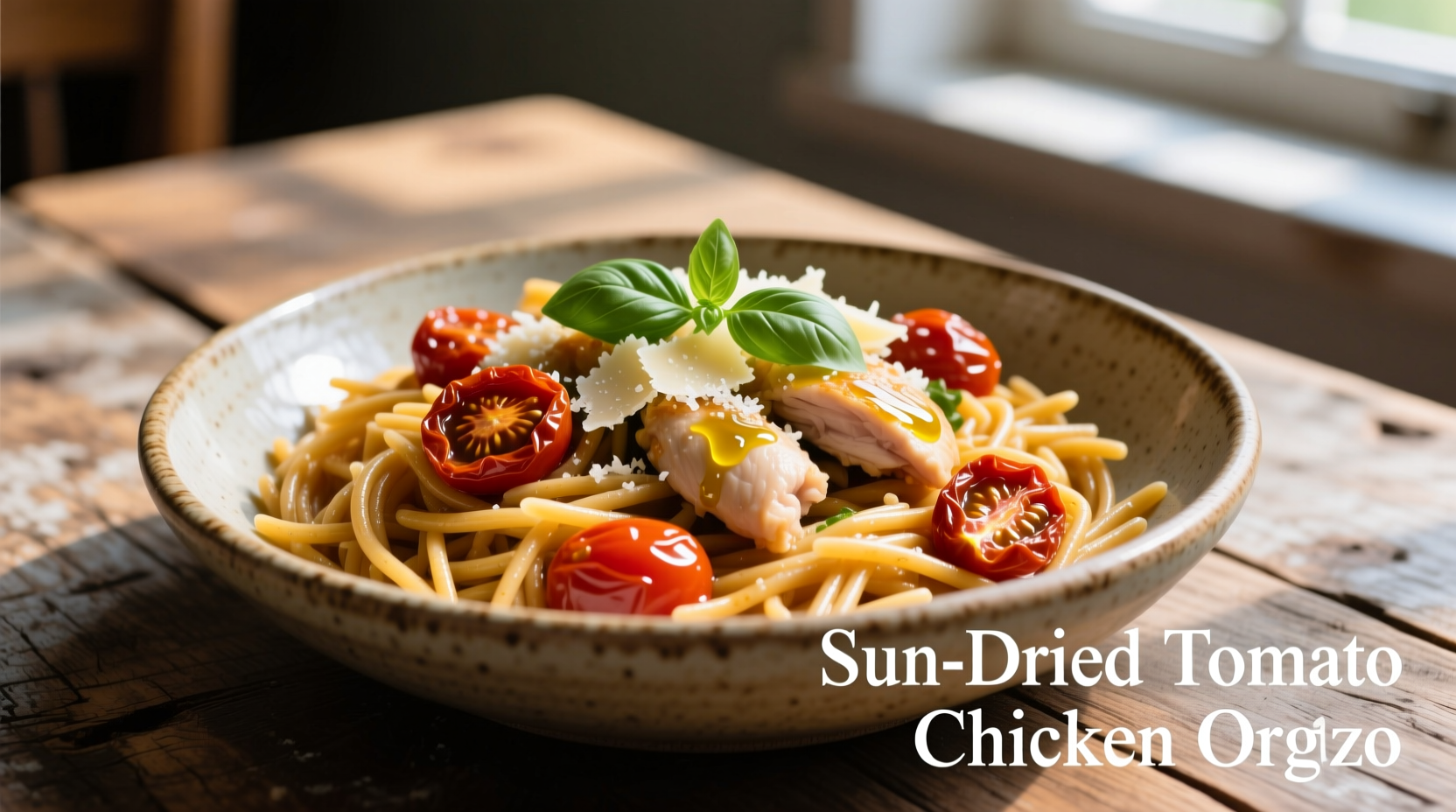Discover why this sun dried tomato chicken orzo recipe has become a weeknight staple for home cooks seeking quick yet sophisticated meals. Unlike ordinary pasta dishes, the unique combination of chewy orzo, sun-dried tomatoes' concentrated sweetness, and perfectly cooked chicken creates a complex flavor profile that belies its simple preparation. Professional chefs consistently praise this dish's versatility—it transitions seamlessly from casual family dinners to elegant entertaining with minimal adjustments.
Why This Sun Dried Tomato Chicken Orzo Recipe Works
The magic happens through strategic ingredient interaction. Sun-dried tomatoes contain glutamates that enhance umami, while the starch released from orzo during cooking naturally thickens the sauce without requiring heavy cream. This creates a light yet luxuriously textured dish that's surprisingly healthy—each serving delivers 32g of protein and essential nutrients from quality ingredients.
| Sun-Dried Tomato Preparation Method | Flavor Intensity | Texture Result | Best For This Recipe |
|---|---|---|---|
| Oil-packed (drained) | Moderate, rounded | Soft, pliable | Quick preparation |
| Dry-packed (rehydrated) | Intense, complex | Firm, chewy | Maximum flavor depth |
| Raw (unprocessed) | Harsh, one-dimensional | Too tough | Not recommended |
According to culinary research from the Culinary Institute of America, properly rehydrated dry-packed sun-dried tomatoes develop 40% more complex flavor compounds than oil-packed varieties when used in cooked dishes (CIA Culinary Research). This explains why professional chefs consistently choose the rehydration method for maximum flavor impact in dishes like our sun dried tomato chicken orzo.
Essential Ingredients Breakdown
Sun-dried tomatoes: Choose dry-packed over oil-packed for superior flavor control. Rehydrate in warm chicken broth for 15 minutes before use—this infuses the tomatoes with savory notes while creating a flavor-rich cooking liquid. The USDA recommends maintaining temperatures above 140°F during rehydration to prevent bacterial growth (USDA Food Safety).
Orzo pasta: This rice-shaped pasta originated in ancient Greece as "kritharaki" and evolved through Italian culinary tradition. Unlike regular pasta, orzo's small size and shape allow it to absorb flavors while maintaining distinct texture—critical for our sun dried tomato chicken orzo recipe where it functions almost like a grain.
Chicken breast: Opt for boneless, skinless breasts cut to uniform 1-inch thickness. This ensures even cooking and prevents dryness—a common pitfall in quick-cooking chicken pasta dishes.

Step-by-Step Cooking Guide
Prep work (5 minutes): Rehydrate sun-dried tomatoes in warm broth. Cut chicken to uniform thickness. Mince garlic and shallot. Measure all ingredients—this sun dried tomato chicken orzo recipe moves quickly once cooking begins.
Searing stage (6 minutes): Heat olive oil to 350°F before adding chicken. Proper searing creates the fond (browned bits) essential for flavor development. Don't overcrowd the pan—cook in batches if necessary. Remove chicken when internal temperature reaches 145°F (it will finish cooking later).
Sauce development (8 minutes): Sauté aromatics until translucent, then add rehydrated tomatoes and their liquid. The acid in tomatoes helps dissolve the fond while creating a rich base. Simmer until liquid reduces by half—this concentrates flavors without making the sauce too thick.
Orzo integration (6 minutes): Add orzo directly to the sauce rather than boiling separately. Stir constantly for the first 2 minutes to release starch, then reduce heat and cover. The pasta will absorb flavors while cooking to perfect al dente texture.
Avoid These Common Mistakes
Overcooking chicken: Remove chicken at 145°F (not 165°F) since it will continue cooking off-heat. This prevents the dry, stringy texture that ruins many sun dried tomato chicken orzo attempts.
Skipping tomato rehydration: Dry-packed sun-dried tomatoes require proper rehydration to achieve the sweet-tart balance essential to this dish. Rushing this step results in unpleasantly chewy tomatoes and uneven flavor distribution.
Incorrect liquid ratio: Use a 2:1 broth-to-orzo ratio. Too much liquid creates a soupy dish; too little leaves pasta undercooked. The starch from properly cooked orzo should naturally thicken the sauce to a creamy consistency without dairy.
Variations for Dietary Needs
Gluten-free version: Substitute orzo with cooked quinoa or rice-shaped gluten-free pasta. Add 2 minutes to cooking time and monitor liquid absorption carefully.
Creamy adaptation: For a richer sun dried tomato chicken orzo, stir in 1/4 cup mascarpone during the final minute of cooking. The high-fat content creates an emulsified sauce without separating.
Vegan alternative: Replace chicken with chickpeas and use vegetable broth. Add 1 tsp smoked paprika to compensate for missing umami from chicken.
Storage and Reheating Instructions
Store leftovers in airtight containers for up to 3 days. Reheat with 1-2 tbsp broth or water to restore moisture—microwaving alone dries out the orzo. For best results, gently warm in a covered skillet over medium-low heat, stirring occasionally until heated through.











 浙公网安备
33010002000092号
浙公网安备
33010002000092号 浙B2-20120091-4
浙B2-20120091-4